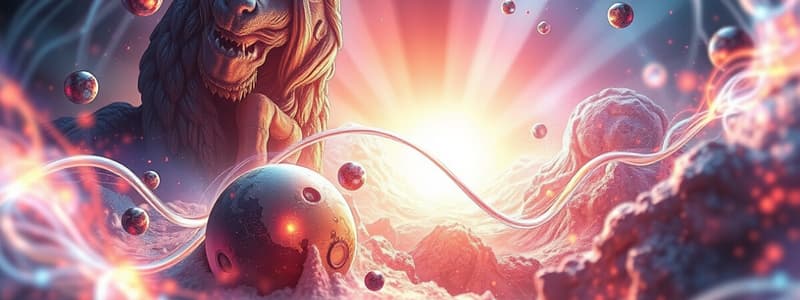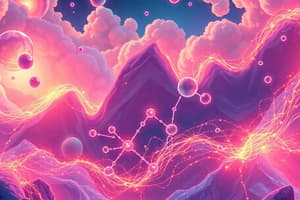Podcast
Questions and Answers
What factors influence the rate of a chemical reaction?
What factors influence the rate of a chemical reaction?
- Pressure, concentration, surface area, and catalysts
- Temperature, concentration, surface area, and catalysts (correct)
- Temperature, pressure, surface area, and volume
- Temperature, concentration, surface area, and pH
In the general rate law expression, which terms represent the reaction orders?
In the general rate law expression, which terms represent the reaction orders?
- A and B
- k and m
- m and n (correct)
- k and n
According to Le Chatelier's Principle, what will happen if the concentration of a reactant is increased in a system at equilibrium?
According to Le Chatelier's Principle, what will happen if the concentration of a reactant is increased in a system at equilibrium?
- The system will shift to increase the temperature
- The system remains unchanged
- The system will favor the reverse reaction
- The system will favor the forward reaction (correct)
Which expression correctly represents the equilibrium constant (K) for the reaction aA + bB ⇌ cC + dD?
Which expression correctly represents the equilibrium constant (K) for the reaction aA + bB ⇌ cC + dD?
What is indicated by a negative ΔG in a reaction?
What is indicated by a negative ΔG in a reaction?
Which law states that energy cannot be created or destroyed?
Which law states that energy cannot be created or destroyed?
What does the activation energy (Ea) represent in a chemical reaction?
What does the activation energy (Ea) represent in a chemical reaction?
How does temperature generally affect the entropy of a system?
How does temperature generally affect the entropy of a system?
What is the primary focus of molecular spectroscopy?
What is the primary focus of molecular spectroscopy?
Which type of spectroscopy is primarily used for identifying functional groups in molecules?
Which type of spectroscopy is primarily used for identifying functional groups in molecules?
In which situation is UV-Vis spectroscopy most useful?
In which situation is UV-Vis spectroscopy most useful?
What do selection rules in molecular spectroscopy determine?
What do selection rules in molecular spectroscopy determine?
Which spectroscopy technique is based on inelastic scattering of light?
Which spectroscopy technique is based on inelastic scattering of light?
What type of information does Nuclear Magnetic Resonance (NMR) spectroscopy provide?
What type of information does Nuclear Magnetic Resonance (NMR) spectroscopy provide?
What role do spectrometers play in molecular spectroscopy?
What role do spectrometers play in molecular spectroscopy?
How does Raman spectroscopy complement infrared (IR) spectroscopy?
How does Raman spectroscopy complement infrared (IR) spectroscopy?
Study Notes
Physical Chemistry Study Notes
Kinetics
- Definition: Study of the rates of chemical reactions and the factors affecting them.
- Rate of Reaction:
- Expressed as change in concentration over time.
- Influenced by temperature, concentration, surface area, and catalysts.
- Rate Laws:
- Mathematical expressions relating reaction rate to reactant concentrations.
- General form: Rate = k[A]^m[B]^n, where k = rate constant, m and n = reaction orders.
- Activation Energy:
- Minimum energy required for a reaction to occur.
- Can be determined using the Arrhenius equation: k = A * e^(-Ea/RT).
- Reaction Mechanisms:
- Stepwise processes through which reactants convert to products.
- Intermediate species may form and disappear as the reaction progresses.
Chemical Equilibrium
- Definition: State in which the forward and reverse reactions occur at equal rates.
- Equilibrium Constant (K):
- Ratio of concentrations of products to reactants at equilibrium.
- For a reaction aA + bB ⇌ cC + dD: K = [C]^c[D]^d / [A]^a[B]^b.
- Le Chatelier's Principle:
- If a system at equilibrium is disturbed, the system adjusts to counteract the disturbance.
- Factors: concentration changes, temperature, and pressure (for gaseous reactions).
- Types of Equilibria:
- Homogeneous: All reactants and products in the same phase.
- Heterogeneous: Reactants and products in different phases.
Thermodynamics
- First Law: Energy cannot be created or destroyed, only transformed (Conservation of Energy).
- Enthalpy (H):
- Heat content of a system at constant pressure.
- ΔH indicates heat absorbed (positive) or released (negative) during a reaction.
- Gibbs Free Energy (G):
- Predicts spontaneity of a reaction: ΔG = ΔH - TΔS.
- If ΔG < 0, the reaction is spontaneous; if ΔG > 0, it is non-spontaneous.
- Entropy (S):
- Measure of disorder or randomness in a system.
- Generally increases with temperature and volume.
Spectroscopy
- Definition: Study of the interaction between matter and electromagnetic radiation.
- Types of Spectroscopy:
- UV-Vis Spectroscopy: Analyzes electronic transitions; used for identifying compounds.
- Infrared (IR) Spectroscopy: Studies molecular vibrations; indicates functional groups.
- Nuclear Magnetic Resonance (NMR) Spectroscopy: Provides information on molecular structure through magnetic properties of nuclei.
- Beer-Lambert Law:
- Relates absorbance to concentration: A = εlc, where A = absorbance, ε = molar absorptivity, l = path length, c = concentration.
- Mass Spectrometry:
- Technique for determining molecular mass and structure; involves ionization and fragmentation of molecules.
Kinetics
- Study rates of chemical reactions and their influencing factors.
- Reaction rate is defined as the change in concentration over time.
- Factors affecting reaction rates include temperature, concentration, surface area, and the presence of catalysts.
- Rate laws express the relationship between the reaction rate and concentrations of reactants.
- General form of rate law: Rate = k[A]^m[B]^n, where k is the rate constant, and m and n are the orders of the reaction with respect to A and B.
- Activation energy is the minimum energy necessary for a reaction to proceed, calculable using the Arrhenius equation: k = A * e^(-Ea/RT).
- Reaction mechanisms consist of stepwise pathways that convert reactants into products, often involving intermediate species.
Chemical Equilibrium
- Equilibrium describes a condition where the forward and reverse reaction rates are equal.
- The equilibrium constant (K) reflects the ratio of product concentrations to reactant concentrations at equilibrium.
- For the reaction aA + bB ⇌ cC + dD, K is defined as K = [C]^c[D]^d / [A]^a[B]^b.
- Le Chatelier's Principle states that if an equilibrium system is disturbed, the system responds to counteract the disturbance.
- Disturbances can involve changes in concentration, temperature, or pressure affecting gaseous reactions.
- Types of equilibria include homogeneous (same phase) and heterogeneous (different phases) equilibria.
Thermodynamics
- The First Law of Thermodynamics emphasizes the conservation of energy: energy cannot be created or destroyed, only transformed.
- Enthalpy (H) indicates the heat content of a system at constant pressure, with ΔH representing the heat absorbed (positive) or released (negative) during a reaction.
- Gibbs Free Energy (G) assesses the spontaneity of a reaction through the equation ΔG = ΔH - TΔS.
- A negative ΔG indicates a spontaneous reaction, while a positive ΔG signals a non-spontaneous reaction.
- Entropy (S) quantifies disorder or randomness; it typically increases with temperature and volume.
Spectroscopy
- Spectroscopy examines how matter interacts with electromagnetic radiation.
- Types of spectroscopy include:
- UV-Vis Spectroscopy: detects electronic transitions useful for compound identification.
- Infrared (IR) Spectroscopy: analyzes molecular vibrations to infer functional groups present.
- Nuclear Magnetic Resonance (NMR) Spectroscopy: reveals molecular structure by observing magnetic properties of nuclei.
- The Beer-Lambert Law describes the relationship between absorbance (A), concentration (c), path length (l), and molar absorptivity (ε): A = εlc.
- Mass Spectrometry is a technique for assessing molecular mass and structure, involving ionization and fragmentation processes.
Molecular Spectroscopy
- Study of electromagnetic radiation's interaction with matter, focusing on molecule transitions between energy states.
Types of Spectroscopy
-
Infrared (IR) Spectroscopy:
- Evaluates molecular vibrations.
- Crucial for identifying functional groups within molecules.
- Absorption peaks indicate specific bond vibrations.
-
Ultraviolet-Visible (UV-Vis) Spectroscopy:
- Analyzes electronic transitions within molecules.
- Particularly useful for studying conjugated systems.
- Absorption results in electronic excitation of molecular states.
-
Nuclear Magnetic Resonance (NMR) Spectroscopy:
- Utilizes the magnetic properties of atomic nuclei to gather information.
- Offers insights into molecular structure and dynamics.
- Chemical shifts represent electronic environments, aiding in structure elucidation.
-
Raman Spectroscopy:
- Based on the inelastic scattering of light, providing complementary data to IR.
- Effective for studying molecular symmetry and structural characteristics.
Key Concepts
-
Energy Levels:
- Molecules possess quantized energy levels, including vibrational, rotational, and electronic states.
-
Transitions:
- Light absorption or emission occurs when molecules shift between energy levels.
-
Selection Rules:
- Criteria dictating the probability of transitions based on conservation laws and molecular symmetry.
Applications
- Structural determination of both organic and inorganic compounds.
- Analysis of chemical bonds and interactions between molecules.
- Monitoring chemical reactions and kinetic processes.
- Quality control measures in pharmaceuticals and materials science.
Instrumentation
-
Spectrometers:
- Measure light intensity as a function of wavelength or frequency.
-
Detectors:
- Convert light signals into electrical signals for subsequent analysis (e.g., photodiodes, CCDs).
Data Interpretation
-
Spectral Peaks:
- Indicate specific molecular transitions and correlate with molecular structures.
-
Peak Position:
- Reflects energy differences between states, influenced by the molecular environment.
-
Peak Intensity:
- Correlates with the concentration of the absorbing species in the sample.
Limitations
- Sample purity and concentration impact the reliability of results.
- Overlapping signals in complex mixtures complicate spectral interpretation.
Studying That Suits You
Use AI to generate personalized quizzes and flashcards to suit your learning preferences.
Description
Explore the fundamental concepts of kinetics and chemical equilibrium in this comprehensive quiz. Test your understanding of reaction rates, rate laws, activation energy, and the principles governing equilibrium. Perfect for students studying physical chemistry!



